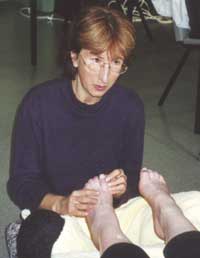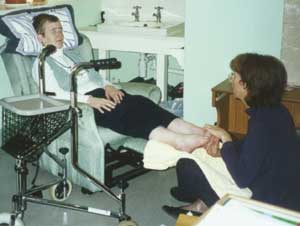Positive Health Online
Your Country

Intuition and Sound Reflexology
listed in reflexology, originally published in issue 63 - April 2001
The development of Intuition and Sound Reflexology was a gradual progression for me. I found that the traditional benefits of reflexology, treating the whole body and a wide range of symptoms for various ailments, could be greatly enhanced by using my own intuitive skills to 'feel' or 'sense' which reflexes were out of balance. Recognizing that the feet encompass the whole body and its systems so easily, I was able to develop an intuitive approach to this ancient art by finding those reflex points that required treatment. I named this 'Intuition Reflexology', which in due course evolved into a treatment incorporating sound as well. Intuition is often called the sixth sense because of its relation to the other five senses that play such an important part in our lives.
For example, the laying-on of hands can be used to direct energy to help or heal someone who is ill. This sense of touch is used in Intuition Reflexology to locate energy blockages in the body. By stimulating or soothing the corresponding reflexes, the person receiving the treatment is able to respond, or 'to heal'.

Helen Perkins vocalizing with intuition and sound reflexology during a treatment
To fully appreciate how this works, it is important to understand that the human body is a living energy, made up of varying electromagnetic particles, forming a dense area that is our physical structure and extending outwards in fine layers, sometimes called the aura. Modern physics together with the Greek and philosophical Eastern traditions have formed new concepts, changing the view we have of health and well-being.
These energies, or life force, which flow through meridians in Chinese medicine (as 'chi') or through chakra energy gateways in Indian medicine (as 'prana'), sustain and regulate the function of the organs and body systems. Symptoms of ill-health can be traced to an energy flow that has been interrupted, causing a blockage, stagnation and disease. The particular area of the body affected has simultaneously changed the surrounding energy field, so it vibrates at a different frequency to when it was healthy. The reflexologist can also use the sense of hearing to 'feel' or be aware of the atmosphere while working with the client. Hearing an inner voice often helps to understand the nature of the complaint and what other reflexes might be useful.
The intuitive reflexologist may also 'smell' something that has a relationship to the problem or nature of the person they are treating. It may even suggest an aromatherapy oil that could be useful, either through application to the appropriate area of the body or used in an oil burner.
Vision through the mind's eye can also occur, for both parties. The client may be relaxed or sleeping well, dreaming of colours and images. At the same time, the reflexologist may 'see' these visions, which might lead on to colour healing. This can be visualized to the client, or involve the use of a colour torch or colour healing bottle touched on the appropriate reflex point.
Using the sense of taste, the reflexologist may experience a flavour, dryness or excessive saliva in the mouth, which indicates some symptom in the client's being that needs to be addressed. Water and diet are vital to good health, and in particular the drinking of fluids after a reflexology treatment helps with the circulation of nutrients and elimination of toxins from the body. Still in this area, the tongue is a vital organ for the power of speech, and the larynx and throat for the passage of air and breathing – in short, the power of life. An extension of this concept is the rapport and communication between client and reflexologist – knowing when to speak and when to be silent.
Music can also be helpful during a session, an idea that I developed when I started to 'hear' a tone whenever I paused on a reflex spot that required balance or healing. Consulting with the client, I started to vocalize with sound as a healing tool on to the particular reflex point – a further use of the sense of the spoken word. Vowel sounds can be pronounced in such a way as to create an effect in parallel to the actual words that carry meaning to the listener. The sense organ that hears these words is the ear, yet the tone or pitch through which it is carried is also a vibration that is felt within the energy field.
In science, Kirlian photography has been used to identify the energy fields around an object, and ultrasound can record a sonar reading of the shape and mass. For those people with a vivid use of intuition and other senses, disease may be perceived, for example, through differences in touch, density and light, temperature, sound, odour, colour, light and shade; there may also be visual imaging and inner feelings.
Intuition Reflexology therefore senses the vibration of each reflex point, while Sound Reflexology makes the corresponding sound. As sound, too, has different frequencies, these can be used to help heal the body. This is not as unusual as it may at first appear. Different cultures over many hundreds of years have used these simple but effective self-help methods that are today becoming more widely recognized and accepted. Musical instruments such as gongs, singing bowls, tuning forks, the Australian didgeridoo, kettledrums and the medieval monochord make sounds for healing. The most recent innovation is using electronic frequencies, such as in the study of cimatics and in radio-frequency acupuncture. There are now many workshops for training or 'freeing' the voice, and the 'voice print' can be identified with certain disorders in the body using bioacoustics.
Intuition and Sound Reflexology uses all the senses to determine the exact pitch, tone or syllable articulation that needs to be vocalized by the reflexologist. The musical pitch, tone and style will vary from one person to another as each client's energy field holds the pattern and uniqueness of that one individual.
The reflexologist senses first with the fingers, interpreting the vibration of the reflex point or area, and then, with the intent of healing or balancing, will produce the sound. The sound is vocalized three times by the reflexologist, with periods of silence in between, to allow for any adjustments that need to be made to the sound if the vibration of the reflex changes. In addition, the silence allows the sound to continue to its destination, penetrating the energy blockage or energizing and complementing its field.
Sound Reflexology can be used with any condition; however, in the case of the long-term or chronically ill, regular Intuition and Sound Reflexology is often able to bring a reversal of symptoms, allowing a better quality of life. 'Singing to the bones' and other skeletal problems also works very well.
Different styles of 'singing' and voice work are practised in the workshops as the Sound Reflexologist needs to be totally uninhibited; intuition or inner feelings may sense a sound that might otherwise be considered discordant or disharmonious. Many cultures around the world use sounds regularly to express themselves: singing, chanting, wailing, shouting or humming. There are many more that can be just as effective for the reflexologist and their client. Clients' responses can vary during treatment – sleep, relaxation, imagined colours, colours in motion like waves or dots, and feelings flowing or pulsating to a specific part of the body.
Those that do not 'see' in this way might sense a tingling, heat, cold or pain in a particular area. Past memories may surface, or emotions such as joy, anger or gratitude. Often, there is an energy shift or realignment, which can be experienced as a twitch or jerk of the body. In some cases, the client may like to join in with the sounds, as a cathartic experience.
In any event, individual response should be encouraged as part of the session – there is no 'right' or 'wrong' reaction – the sixth sense will lead the way.
Case Studies
Case Study 1
Client R: a woman of 73 years, who has upper back scoliosis, with the clavicle and scapula raised slightly on the right side. She has 'tennis elbow' pain in her right side. R manages to live with her back discomfort and has recently found that a course of Intuition Reflexology helped a digestive complaint that otherwise meant surgery. She was willing to try Sound Reflexology for the tennis elbow pain. She had four treatments twice a week for two weeks and was very responsive. She was able to 'see' moving colours and experienced waves of sound coming upward from her feet and directly into her elbow. She relaxed well and the pain was gone after the course and has still not returned after three years.
Case Study 2
Client T: a woman of 50 years, who was physically abused when she was in her forties. She experienced severe pain in her left buttock and thigh and had tried many other therapies. The Sound Reflexology was carried out weekly for six sessions. The sound used was discordant, perhaps reflecting T's pain and anguish from her past trauma. After the fifth treatment, when she reached home, she experienced a severe headache and vomited. The pain had gone the next day. The sixth treatment was used to check that her whole system was in balance after the release.
Case Study 3
Client J: a woman of 63 years, who has diabetes and multiple sclerosis (MS). She has been having regular Intuition Reflexology to help the mobility in her feet as she is able to walk with a frame. As with most cases of MS, one side of the body is affected more than the other side. J's left foot drags when she is walking and her left hand is stiff. Concentrating more on the left hand and foot, Sound Reflexology is being used on a weekly basis. J relaxes well and 'feels' the sound, which is mainly lower tones with vowel pronunciation, move up and around her neck. She is excited by this experience and feels better in herself. This case study is ongoing.

The author with Client J using intuition and sound reflexology at the Sue Ryder Care Hospice in Peterborough
Case Study 4
Client A: a woman of 49 years, who has MS. She is experiencing lower back pain. She has been having reflexology to help the mobility in her hands, enabling her to write. There has also been a problem with constipation, which has been cleared. In applying sound to the reflexology with A, I use deep, comforting sounds with overtones. She sees waving lines of colour, changing their shades and settling into her lower body. Her back pain has been significantly reduced. This case study is ongoing with weekly appointments.
Bibliography
Armstrong Frankie and Pearson Jenny eds. Well-Tuned Women: Growing Strong Through Voicework. The Women's Press. London. p183. ISBN 0-7043-4649-4. 2000.
Batmanghelidj F. Your Body's Many Cries for Water. The Tagman Press. ISBN 0-9530-9215-1. 2000.
Collins Judith. How to See and Read the Human Aura. Lothian Books. Melbourne. Australia. ISBN 0-85091-759-X. 1998.
Furlong David. Develop Your Intuition and Psychic Powers. Bloomsbury. London. ISBN 0-7475-2153-0. 1996.
Gardner Kay. Sounding the Inner Landscape: Music as Medicine. Element. Shaftsbury. ISBN 1-85230-973-3. 1997.
Goldman Jonathan. Healing Sounds: The Power of Harmonics. Element. Shaftsbury. ISBN 1-85230-848-6. 1996.
Krieger Dolores. The Therapeutic Touch. Prentice Hall. New York. ISBN 0-13-914812-4. 1992.
Comments:
-
No Article Comments available